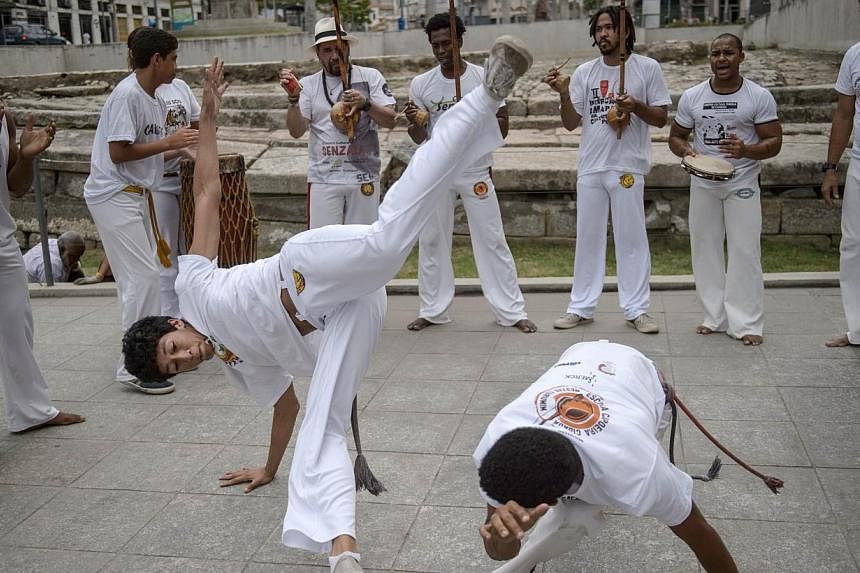Just over a year ago, I stood on a bench at the Istana Park, tiptoeing as I strained to look over a crowd of people standing in a loose circle.
They were playing strange music - among other things, a single-stringed instrument which resembled an archer's bow produced a steady metallic twang - and singing in an unfamiliar language.
In the middle of the throng were two people in loose white pants, circling each other.
Suddenly, they burst into action with high, sweeping kicks passing inches from faces, and acrobatic feints drawing cheers and whoops from the crowd.
That was more than a year ago. Last October, I took part in my own Batizado (Portuguese for baptism). I was the one in the middle of the roda, wearing white abada pants and listening to the characteristic twang of the berimbau. After getting taken down by an instructor, I received my first capoeira belt.
I began learning the Brazilian martial art at the end of 2013 at the behest of my boyfriend, a capoerista who has been training for more than six years.
But when I first stepped through the doors of Bantus Capoeira Singapore academy near Clarke Quay, I had no idea what I was in for.
In my head, the training fulfilled two functions - physical exercise and a great outlet to unleash pent-up aggression, Fight Club style.
It turned out to be a lot more complicated than that.
The first few months were especially difficult - Why am I training in pyjamas? What do all these Portuguese words mean? Even pinning down the ginga - capoeira's basic side-to-side stance - was a nightmare.
"Psychomotor!" my boyfriend would yell at me, pointing out my severe lack of brain-body coordination as I kept lifting the same-side leg and arm together.
But a year after my first clumsy ginga, I am beginning to find the art in martial art.
Capoeira, like many other fighting disciplines, is deeply rooted in tradition and history, and learning it has opened the door to a whole culture and way of life.
Even at a basic level, training in capoeira also means learning a measure of Portuguese, where the deadliest of kicks are paired with beautiful, lyrical names. A high semi-circular kick is a Meia-Lua de Frente or "half moon of the front". A spinning kick with hands planted on the floor is Rabo de Arraia or "tail of the stingray".
There is also an elegance in the flow of capoeira. At the heart of the discipline are rotational kicks, which pass high above the head of the opponent. While capoeira does incorporate snap kicks and knee strikes, the majority of kicks are not meant to be blocked, but evaded.
It is this dynamic which makes the game so interesting.
When experienced capoeristas play, the roda turns into a chessboard, where space and position, instead of brute strength, are the ultimate resources.
Another integral aspect of capoeira is the music, which governs the speed and style of play. Every roda is accompanied by a bateria or band, which is lead by the berimbau and often incorporates Brazilian-style drums and tambourines.
To graduate to the higher belts, an understanding of the instruments is a must, as advanced students are expected to play them during the roda.
The music of capoeira is also a valuable insight into its history. The roots of the form lie in slavery, as African slaves in the then-Portuguese colony of Brazil in the 16th century developed the dance-like movements to hide their martial art training from their masters.
"Se nao fosse o escravo , nao existia a capoeira", goes a popular song or "if not for slavery, capoeira wouldn't exist".
One of my fellow capoeristas, Caneta, trained in taekwondo for six years, and judo and muay thai for one each. After trying out capoeira for a few months, he fell in love with the all-encompassing nature of the form.
"With capoeira, you can't learn it unless you immerse yourself. The songs, the nicknames, you don't get that with other arts that focus heavily on the combat aspect," he says. His real name is Kevin. Caneta is his apelido or nickname, another tradition which harks back to the time when capoeira was outlawed in Brazil.
For me, it is this rich history and culture that takes capoeira beyond an exercise and makes it addictive. Before I took up the discipline, I used to keep fit the regular way, by running, lifting weights and the occasional yoga class.
But once I left the gym or studio, that was it. I went about the rest of my day, satisfied that I had worked out, but thinking nothing more of it.
Now though, I catch myself humming Portuguese songs in the shower. When no one is looking, I press the lift button with a kick.
In all the exercises I used to do, there is no sense of artistry, no creative response to another human body that is trying to engage with yours. But when I open my mouth to sing or when I play the instruments, there is a sense of history, the feeling that I am part of something bigger.
I am sure this happens in other martial arts as well.
Wilson, a friend who has been training in taekwondo for more than five years, says his academy emphasises values such as filial piety and that behind each belt colour lies a rich philosophy.
Admittedly, the history, culture and flow of capoeira are not always at the forefront of my mind. It is hard to see the art when I'm thumping a kickpad as hard as I can or when I'm struggling with the last few painful inches of a full split.
It is also not the most injury-free of exercises. The soles of my feet are permanently layered with blisters and a poorly timed defence earned me a purple and yellow bruise above my right eye for weeks. Bruises and sprains are common and attempting a flip a month ago landed me with a finger injury that flares up even now.
But all that is forgotten the moment the berimbau starts playing and I step into the roda, locking eyes with a fellow capoerista.
As my feet find the rhythm of the music and my body reacts to the space around me, I am wholly consumed by the moment, yet transported to another plane.
To me, that is the very essence of art.


